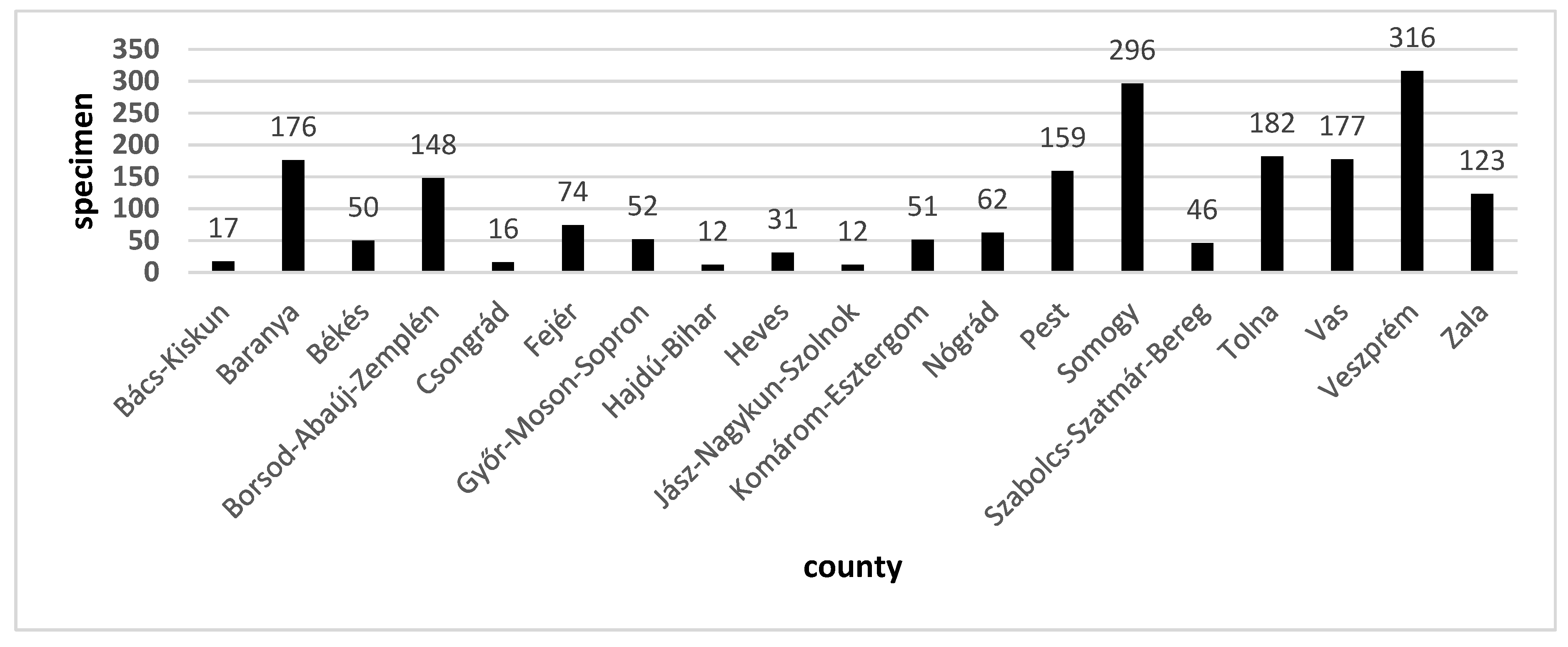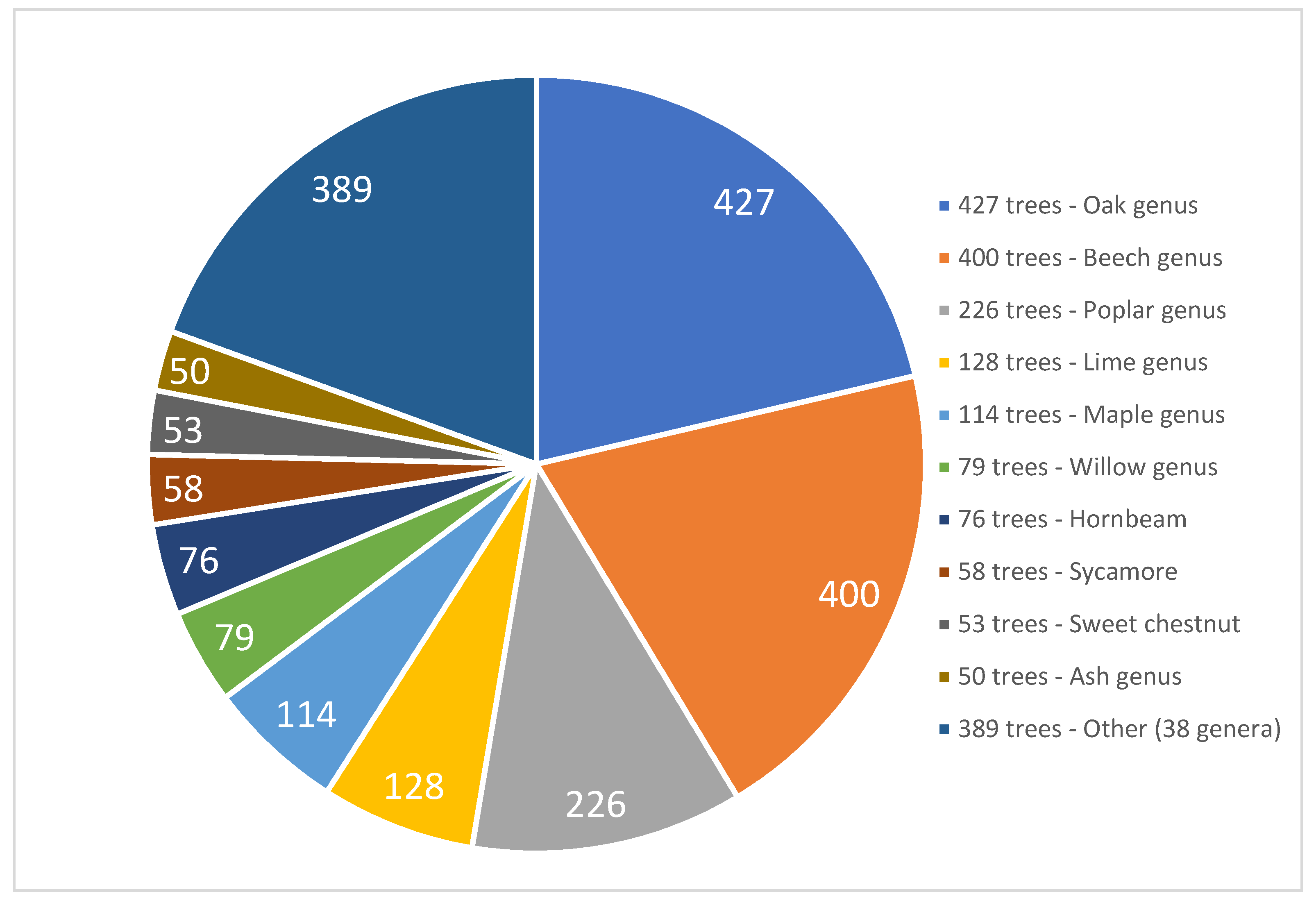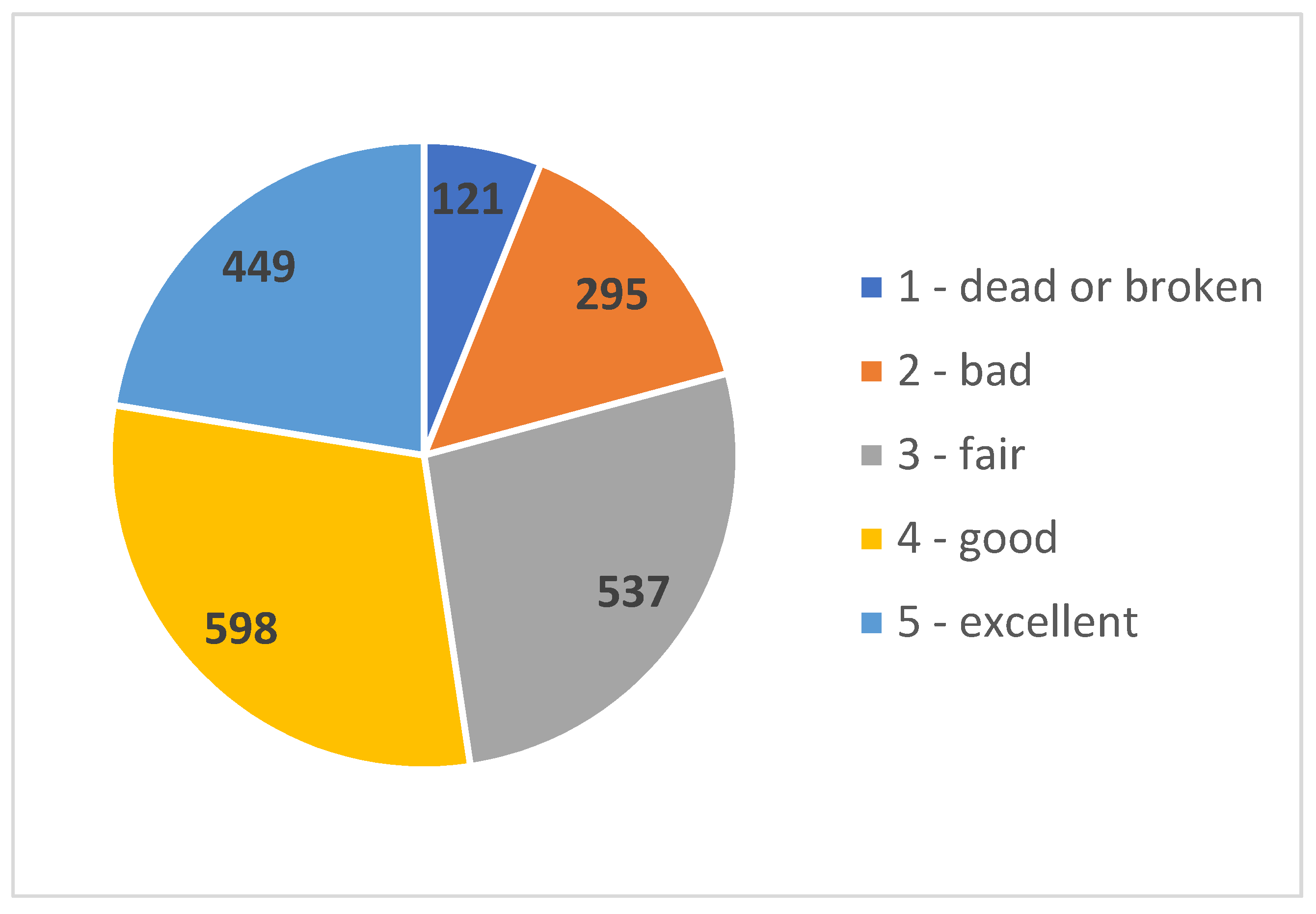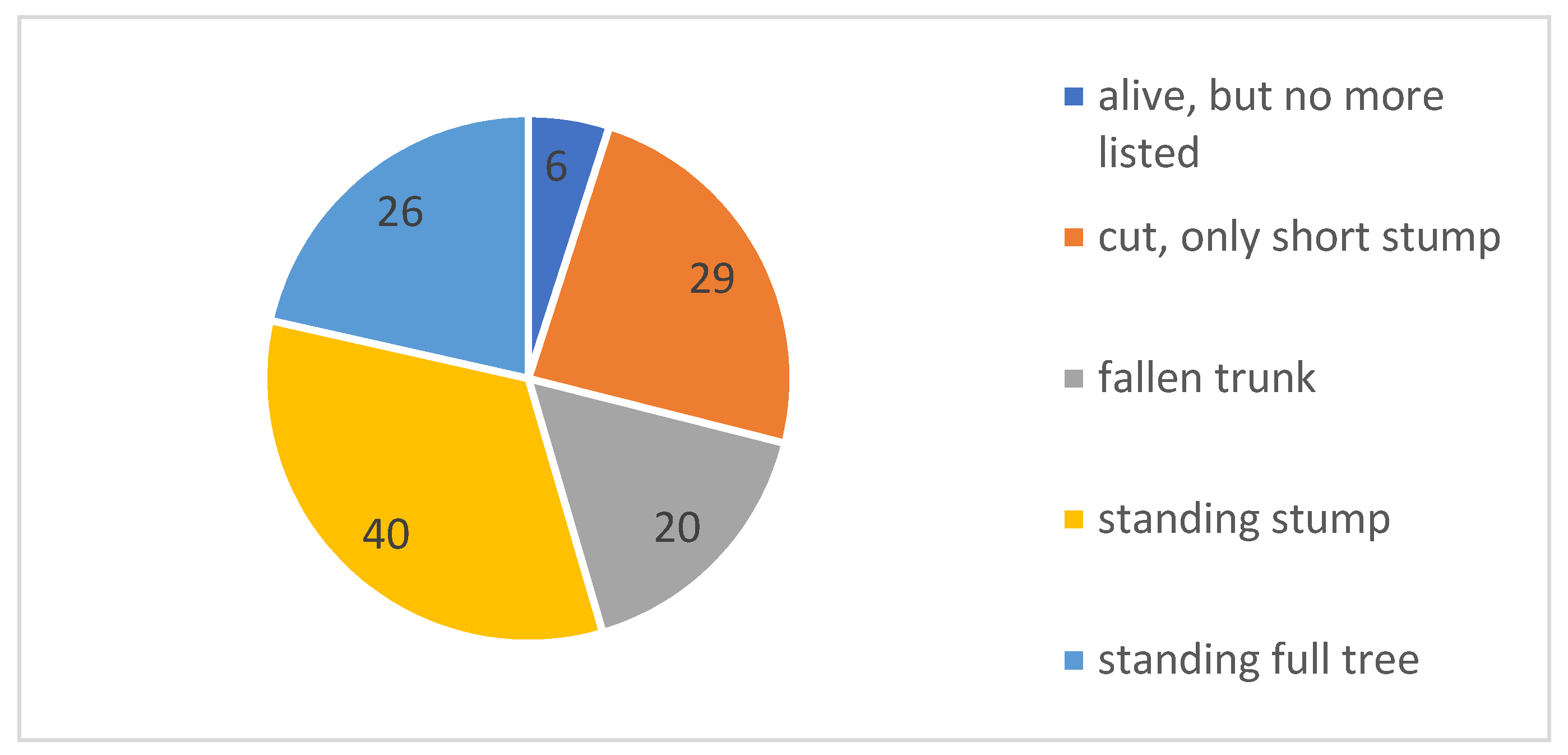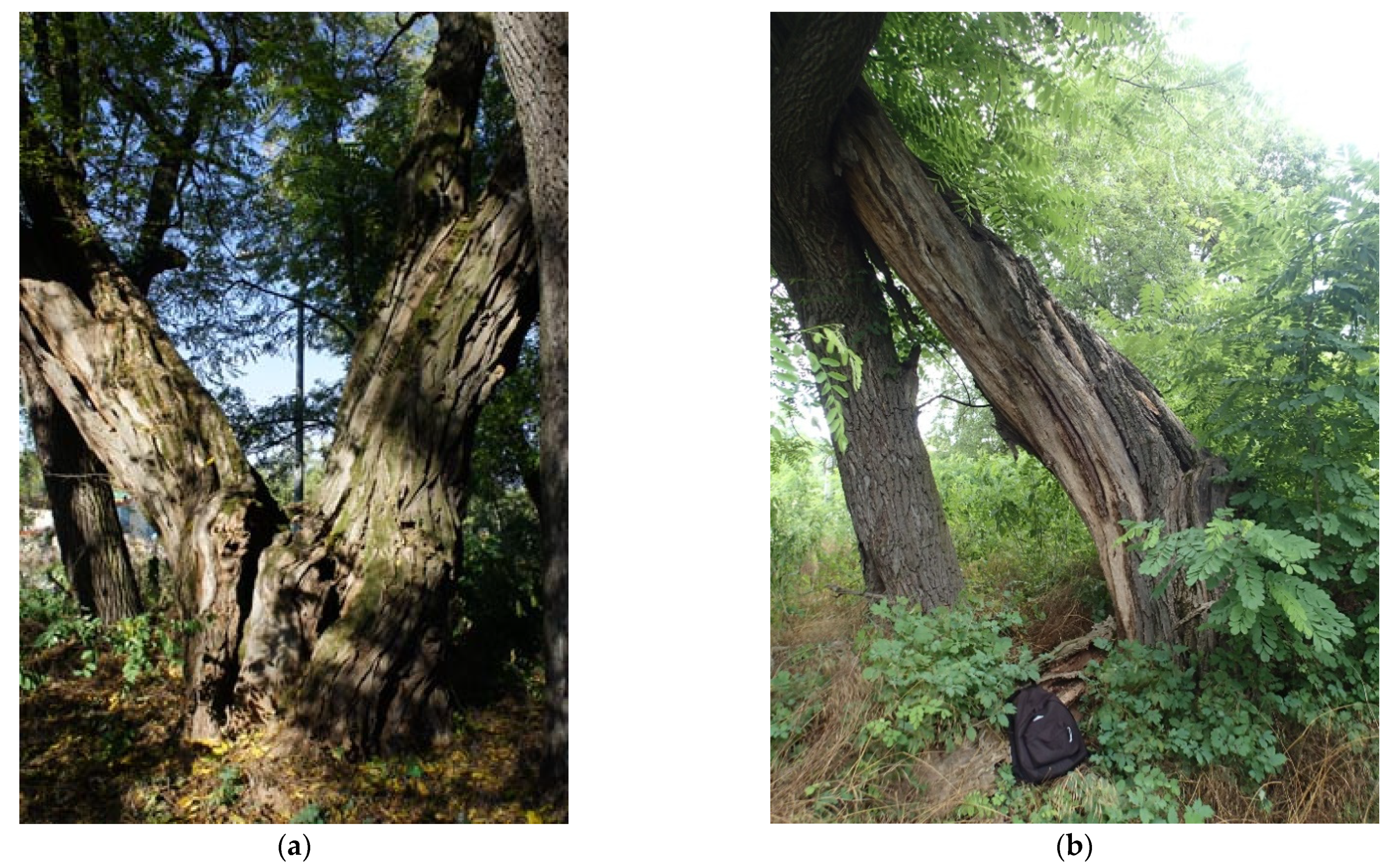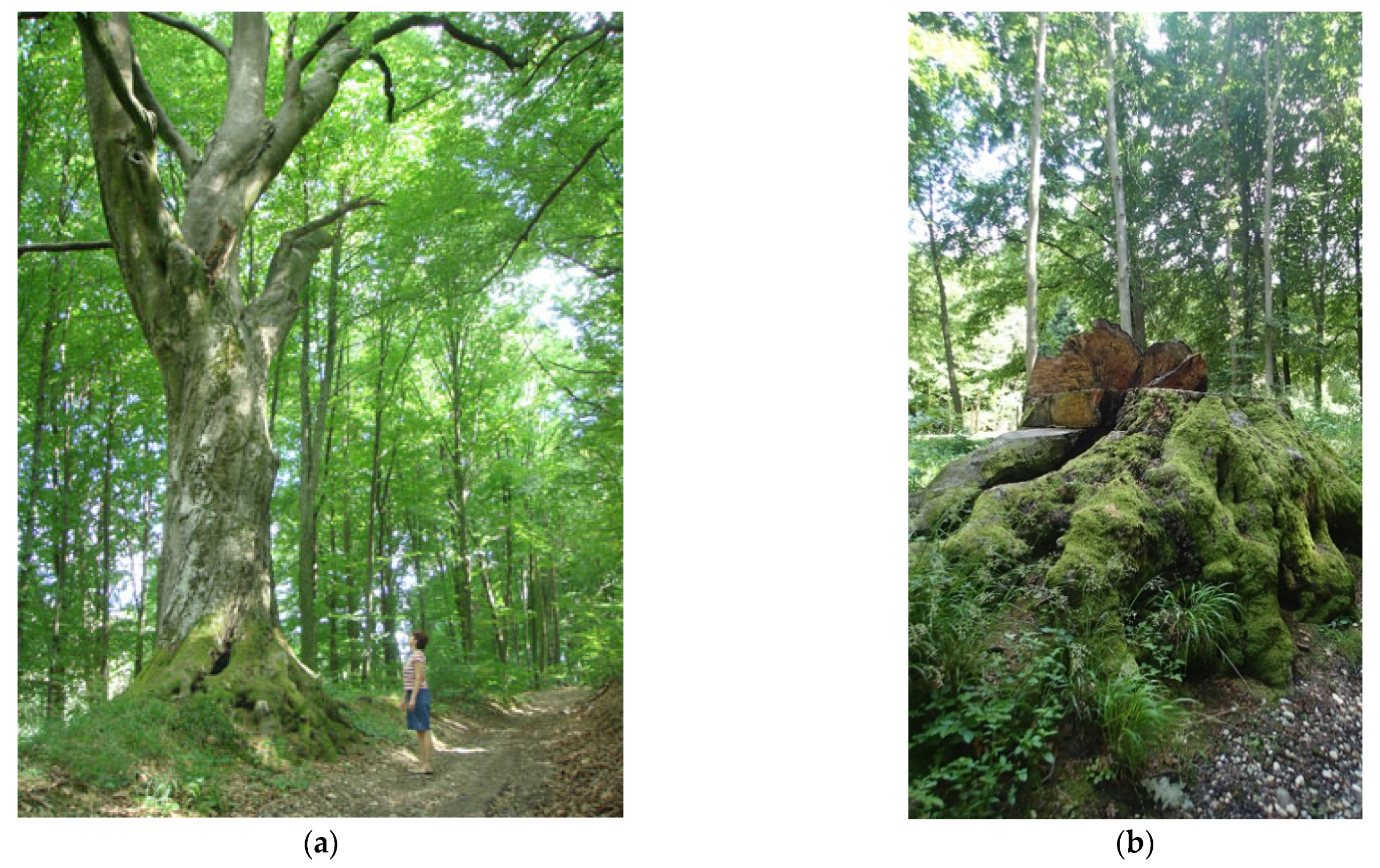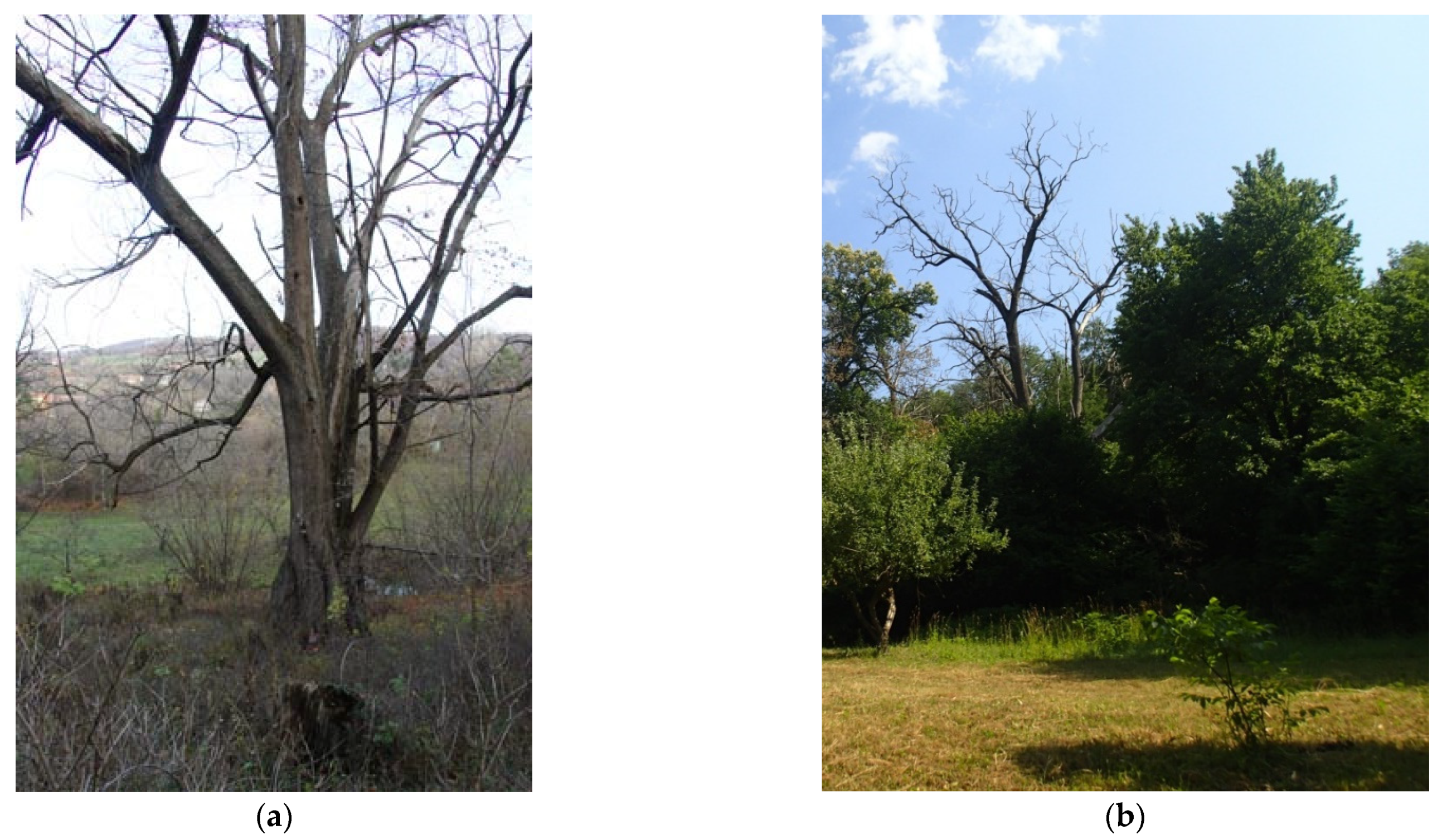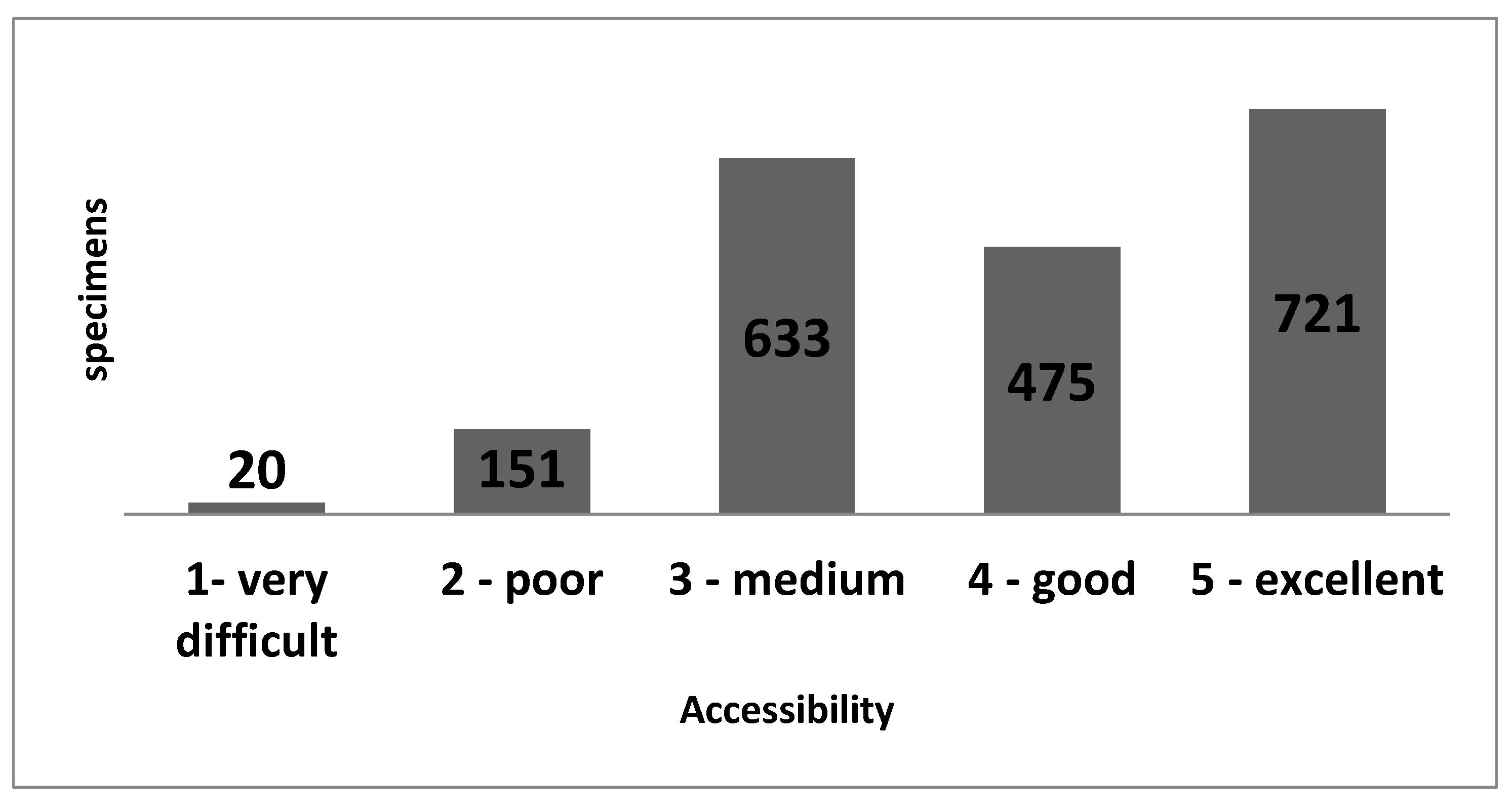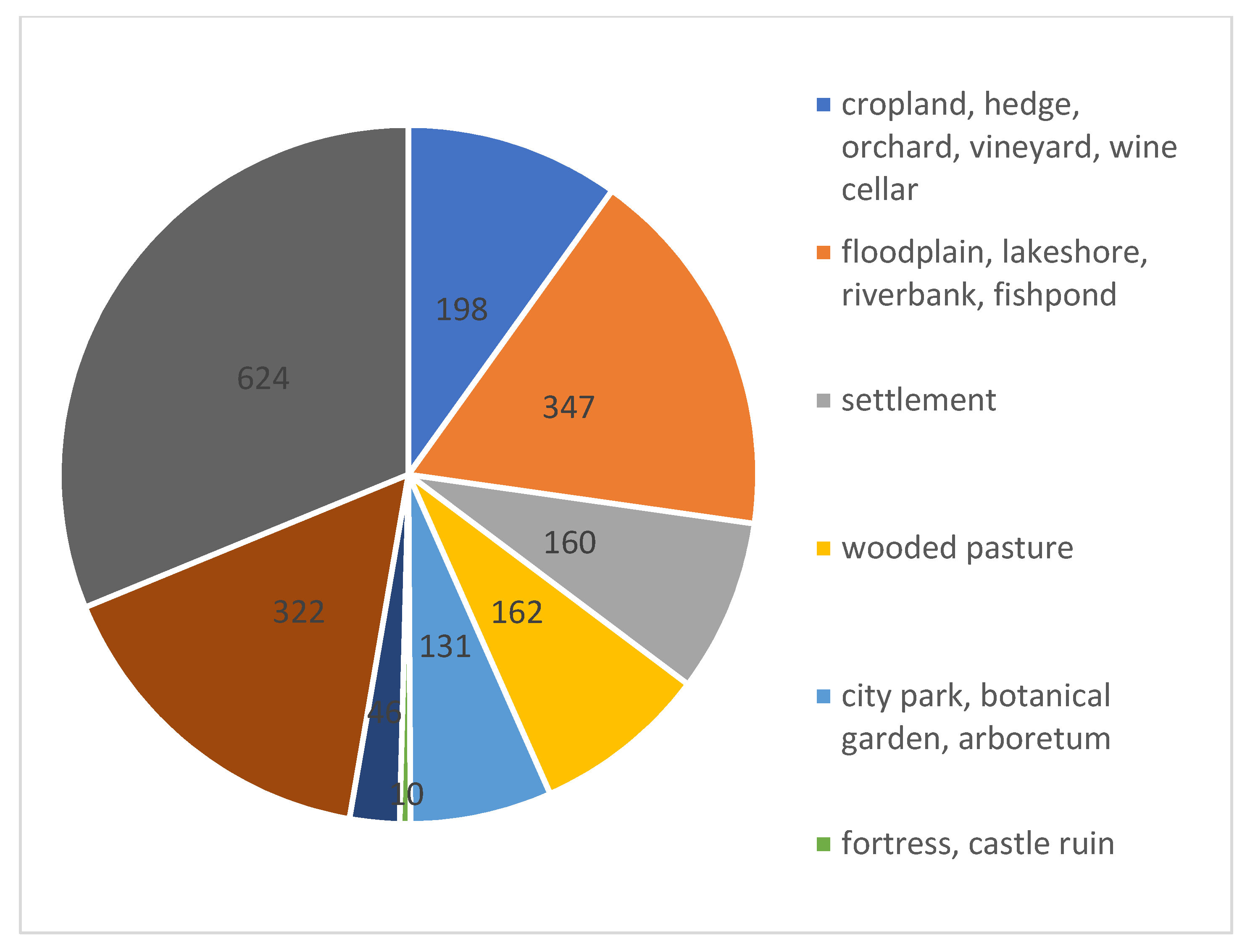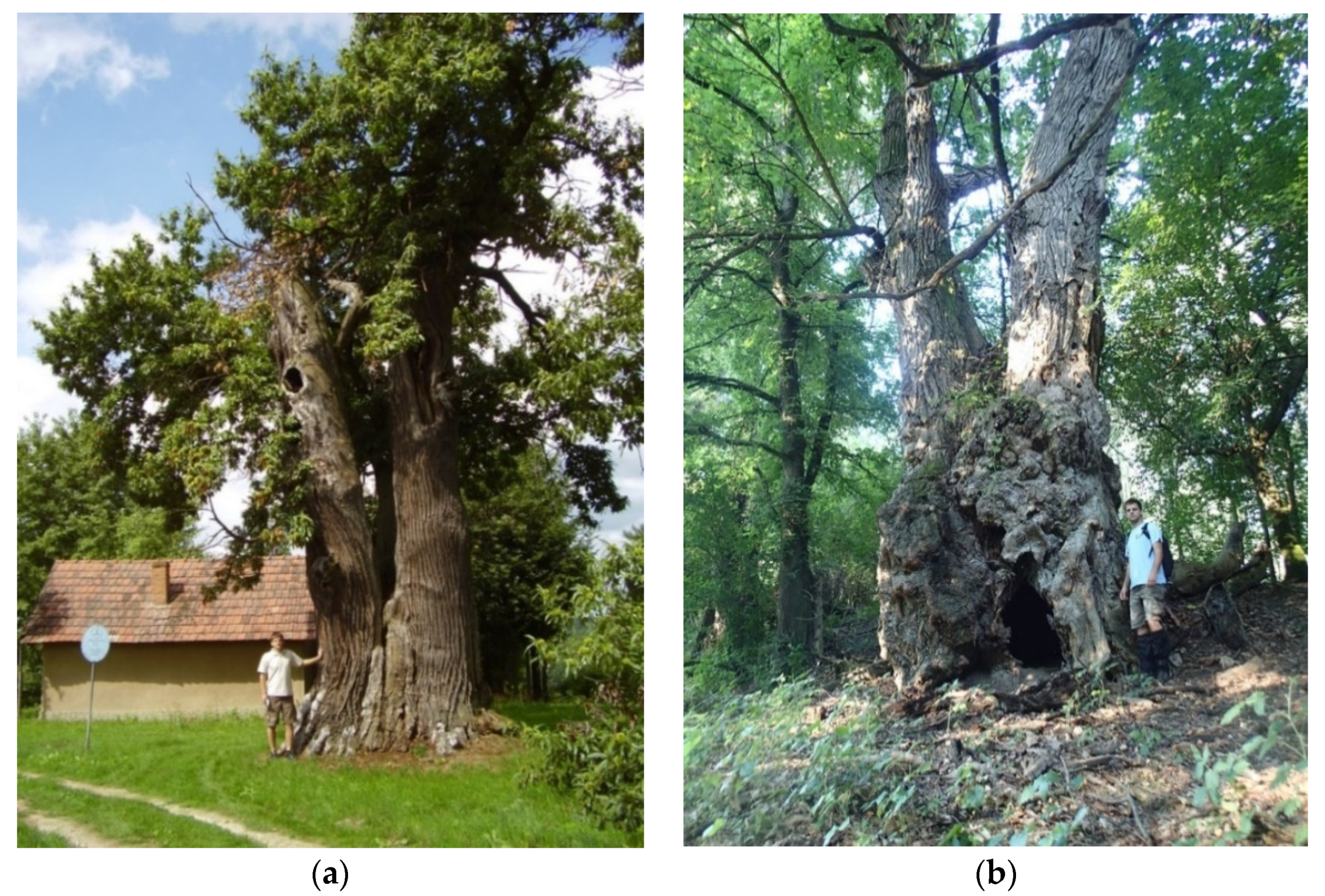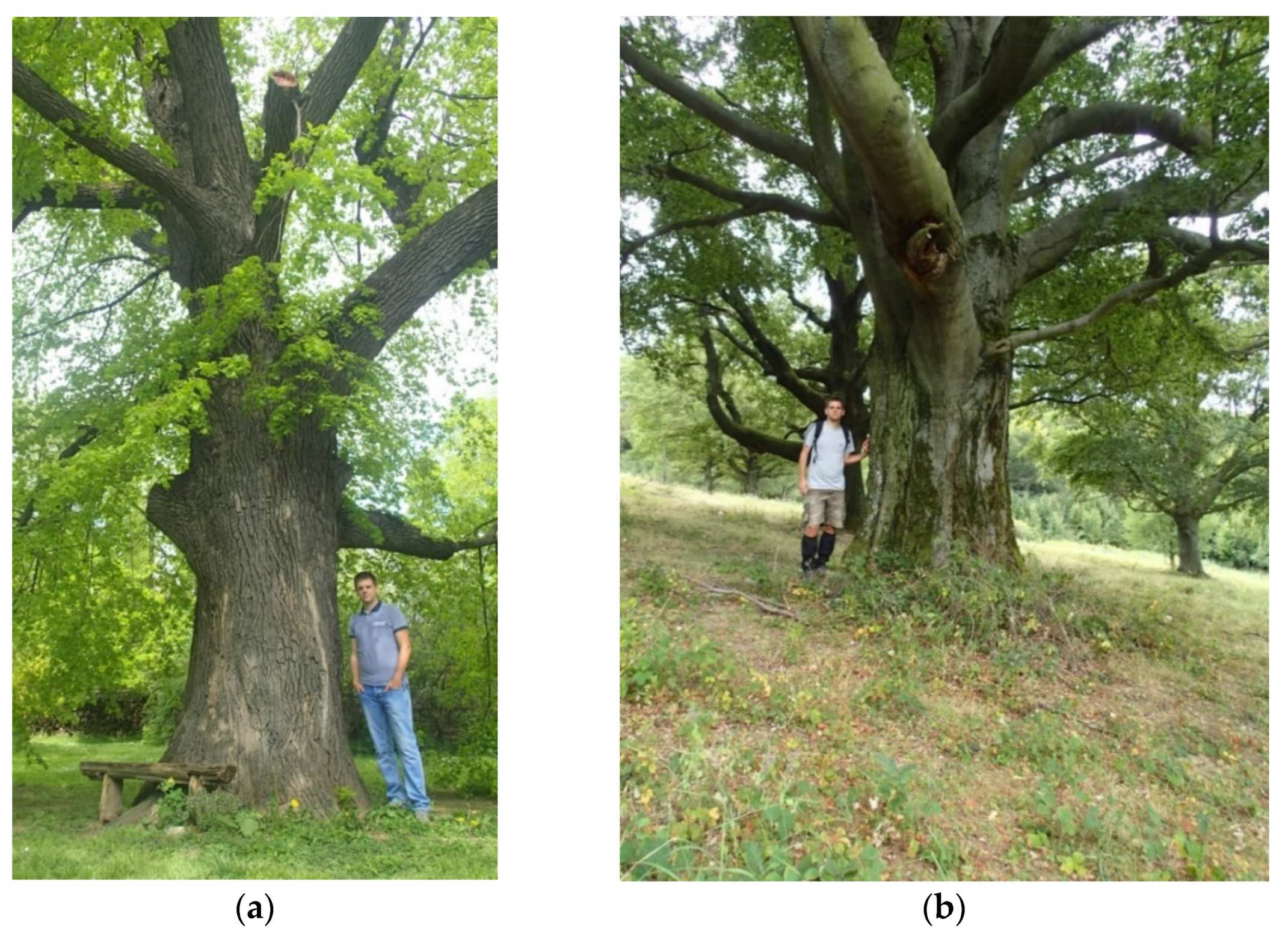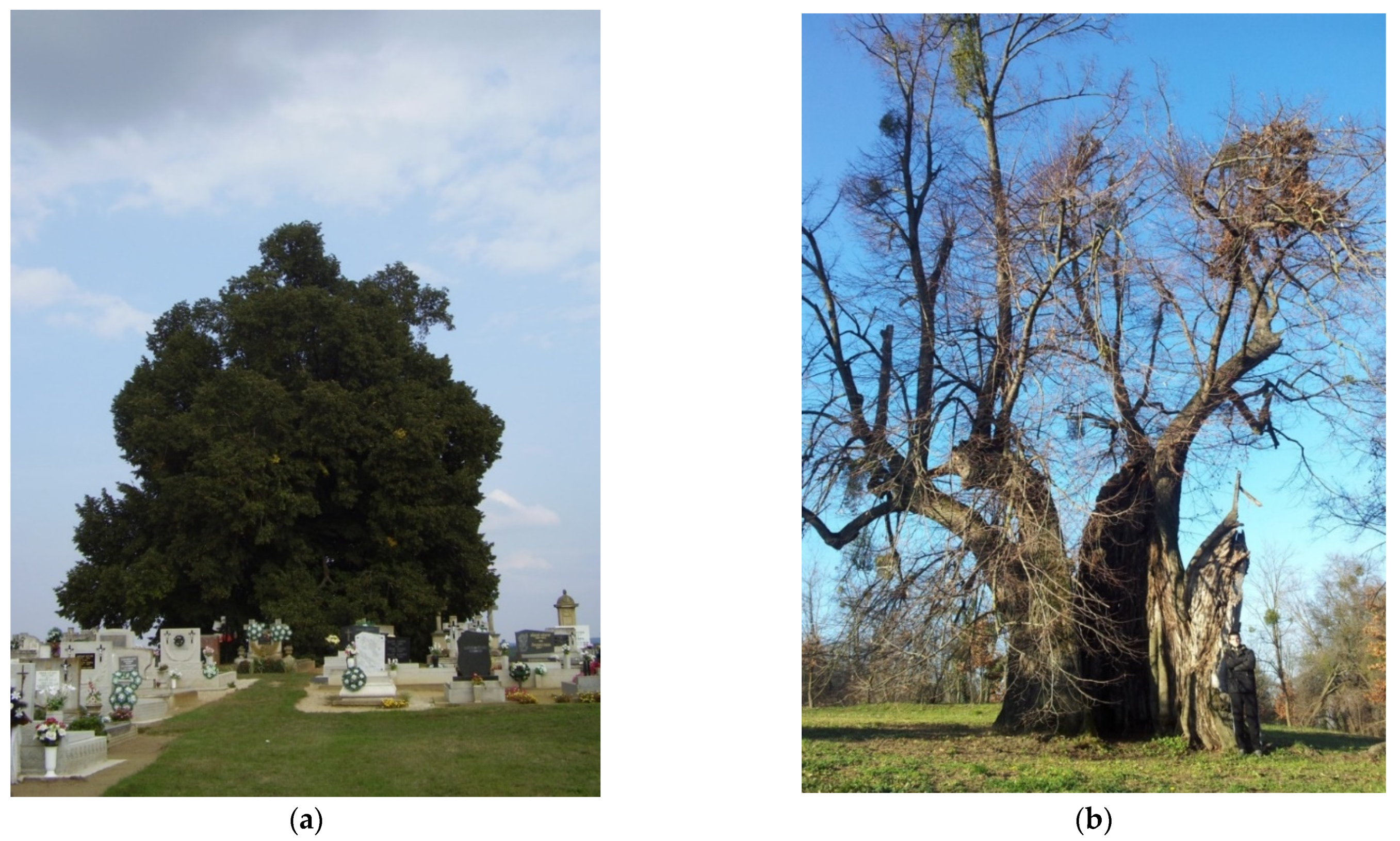1. Introduction
Ancient trees are the biggest or tallest trees per species in a defined local area. Some of them are the tallest ones or the ones with the biggest girth per species in the whole country—these are called ancient trees [
1]. The trees belonging to these categories contribute to ecosystem services such as carbon storage, water retention, and microclimate regulation and contain several types of microhabitats (e.g., hollows, wood mold, decaying wood in the crown, or flaking bark), which support specialized saproxylic species, including fungi, lichens, and other epiphytes, etc. Some of these rely solely on decaying wood. Several vertebrate groups make use of ancient tree habitats as well [
1,
2]. In the case of saproxylic beetles, species in the dead wood of the upper canopy are different from those in other parts of the tree [
2]. This is why the ancient trees play a significant role in every ecosystem, even in urban areas [
3,
4]. They carry aesthetic and spiritual values as well [
5] and are important genetic resources for the future [
6].
There are a lot of interesting, large trees in Hungary. Among these, probably the most interesting ones are those which preserve memories, traditions, and folk legends, and deserve recognition due to their size and age as well. Several tree species and genera were tied to gods, kings, and spiritual persons during the past millennia. Folk traditions have attached legends, renewal, love, and brightness—or their opposite—to the trees as symbols. As an example, we processed various sources to present the cult that surrounds the lime tree genus (
Tilia spp.), one quote tells the following: “Once upon a time the trees were the residences of the gods…” [
7]. Before the appearance of the black locust (
Robinia pseudoacacia), lime trees had been the most important plants for bees in Central Europe. It is likely that southern Slavic people named the June month after the lime tree, due to its flowering time (lipa—lime tree; lipanj—June) [
8]. People in the ancient times and the Middle Ages believed that there were ghosts in the trees. The lime tree appears in the heraldry as well: its golden leaves are on the helmet of King and Emperor Sigismund of Luxemburg. There was also a lime tree leaf in the former coat of arms of Kyiv City. Folk legends connect lime trees to ancient persons in Hungarian history. We know the history of the old lime tree in Mad (Slovakia) from [
9]: there was an old lime tree at the border of the settlement, and King Mathias Corvinus often took a rest under its crown. The village cut down the tree because the service of the King and his escort was really expensive. Not seeing his favorite tree on his next visit, the King legislated that the citizens of Mad and their descendants would never receive awards. One of the trees tied to King Mathias Corvinus is still alive in Bojnice (Slovakia). After him, György I. Rákóczi inherited these trees, and the legends began with him. He dated his letter from Zborov (Slovakia), writing: “Datum sub centum tiliis”, i.e., “Dated under the hundred lime trees” [
10]. We know about the royal gardens of the Renaissance from Oláh’s records [
11]. Two trees are recorded, with names, in the garden of King Mathias Corvinus in Visegrád (Hungary), namely the lime tree and the willow. At the beginning of the Renaissance, the popular arbors were built up onto the trees. The well-formed crowns of the lime trees were particularly suitable for this [
10]. The first Hungarian lime alley decorated the garden of King Mathias Corvinus in Visegrád. Later, during the 17th and 18th centuries, several alleys were established, e.g., the one mentioned in Zborov, with 100 trees. After that, “alley-planting” became a device to chain the garden and the surrounding landscape. A wonderful alley was registered in Köpcsény (Austria). A 1000 m-long alley was planted in Bontida (Romania) at the end of 1750s [
10]. Among the lime alleys still alive, the most famous one in Hungary is in Nagycenk. In the UK, lime trees are familiar elements of avenues, especially on historic estates and parkland [
12].
We believe that the biggest trees in Hungary represent extraordinary nature values and qualities, both in forests and cultural landscapes [
13]. This is why we aimed to measure their main diseases, as well as their height and girth (i.e., the distance around the trunk) [
14], the species diversity among the biggest Hungarian trees, their health status, and their accessibility. Three online databases [
15,
16,
17] compile the geographical locations and coordinates (sometimes adding height as well) of the trees with the largest girth. In the UK, the Ancient Tree Inventory is the result of a successful, long-term citizen science recording project [
1], while the longest online compilation in Hungary [
15] was a private initiative. However, later, it was opened for the greater public to complement, but the founder approves the information collected by the public, prior to it being added to the site.
We registered new types of data on the health, accessibility, and environments, etc., of 2000 ancient trees, several being Hungarian champions of each species. The ancient (also mentioned as champion, heritage, momentous, notable, and veteran) trees are in global decline [
18,
19]; therefore, their regular measurement and inventory are of high importance.
2. Materials and Methods
In the case of each listed tree, the longest online compilation in Hungary [
15] provides the smallest girth (the distance around the trunk) that was measured between 0 and 130 cm height. In the case of hornbeam and maple species, they must be 300 cm to be included in the list, while this minimum is 400 cm for beech trees, limes, elms, ashes, and some oaks; 500 cm for sweet chestnut and some oaks; 600 cm for poplars, sycamores, and most willow species. The database contains indigenous and non-indigenous tree species as well, including ornamental trees, fruit trees, and invasive alien species. We started to visit all the 700 trees that were covered by [
15] in 2008. During our investigations, their number in the database grew to 2000 by the year 2018. We decided to make a complete census of the trees listed in the database in 2018, i.e., we visited a total of 2000 specimens throughout the total area of Hungary (531 settlements). The highest number of trees (316) were measured in Veszprém county, where there are several wood pastures with ancient solitary trees. We recorded the smallest numbers on the Great Hungarian Plain (
Figure 1). Based on the methodology [
1] of the Ancient Tree Inventory of the United Kingdom (the most thorough national compilation that we found anywhere in the world), we registered the following data in the cases of each tree: species; location; county; closest settlement; health status; living and standing status (whether the tree is alive or dead, standing or fallen); information about accessibility; local habitat; local historic name (if existing); measured girth at 130 cm height; image; and date.
Age was not registered, because dendrochronological sampling may damage the tree, especially the old ones. We avoided even an estimation of the age, since there is much discussion about the accuracy of the relationship between tree girth or diameter and age [
20,
21].
The health status was presented on a 5-level scale, based on the existence of hollows or breaks, the crown’s state, diseases, and care (
Table 1).
We also recorded if a tree had died or broken (collapsed) and thus, should be no longer listed in the nationwide database [
15]. Time intervals (below 3, 3–6, 6–9, or above 9 years) express elapsed years between the registration date in the database and our detection (the exact time can be shorter, of course, since the tree might have died or broken some years before our visit, but there are no correct studies). International studies usually observe this process at a 10 year rate, but the mentioned Hungarian database was launched only 20 years ago, therefore, it is unhelpful in counting decades. The status of the dead or broken trees at the time of our visit was expressed in 5 categories (
Table 2).
We evaluated the accessibility of each tree based on the road quality that leads there (e.g., usable by car or hard to follow, even by foot), whether there are direction plates both inside and outside the nearest settlements, densely surrounded by scrubs, or the requirement of permission, etc. (
Table 3).
We also aimed to typify the specific location of the trees. Following the methodology of [
1], we formed nine categories (
Table 4) in order to differentiate among the surrounding environments. This factor definitely affects the health status and protection strategy of certain trees, whether they stand in a well-known and easily accessible place, in the middle of an extended natural forest, or in the center of cropland.
3. Results
The measured 2000 trees belong to 72 species—29 indigenous and 43 non-indigenous (
Figure 2). A total of 1550 specimens belong to indigenous species, while 450 are non-indigenous. The most frequent species among the biggest trees are beech trees (
Fagus sylvatica; 400 specimens) and the oak genus (
Quercus spp.; 427 specimens, mostly English oak,
Quercus robur). Poplar genus gives several big trees as well (
Populus spp.; 226 specimens, mostly black poplar,
P. nigra). Most of them (1680) stand in a forest or park: only 320 solitary trees were registered. The majority lives in the North Hungarian Range, while there is a low number in the Great Hungarian Plain. Currently, the biggest known tree in Hungary is a black poplar in the Gemenc forest territory, with a girth of 1180 cm.
3.1. Health Status
In terms of health status, at least three-quarters of the measured trees are in at least fair condition (
Figure 3). However, 6.05% of the measured big trees (i.e., 121 specimens) have died since their first listing in the nationwide database, or they no longer reach the size necessary to be listed (due to breakage etc.). Most of the dead trees are beech trees (
Fagus sylvatica), English oaks (
Quercus robur), and black poplars (
Populus nigra)—not surprisingly, since these are the most numerous species among the big trees. A number of 96 out of the 121 dead trees stood in a forest or a park, while only 25 were solitary trees.
Altogether, 832 trees were found in bad or fair condition, i.e., 41.6%. A total of 135 of them were solitary, while 697 were in a stand (forest or park). Most of them were oaks (211 specimens) and beech trees (155), these were the closest to death. High numbers were detected in the case of the black poplar (81 trees), white willow (66), and hornbeam (42).
More than half of the measured big trees were in good or excellent condition (1047 specimens), with 888 in forests or parks, while 159 were solitary, mostly beeches (196 trees) and English oaks (150). It is important to emphasize that 94.8% of the sycamores (Platanus spp., 55 specimens out of 58) belong to the best two condition groups. However, only 10.5% of the big black locusts (2 out of 19 Robinia pseudoacacia), 16.7% of the big white mulberries (2 out of 12 Morus alba), 10.3% of the big white willows (8 out of 78) are at least in good condition, and 24.5% (13 trees out of 53) is the ratio in the case of the big sweet chestnuts.
3.2. Trees to Be Deleted from the National Database
Altogether, 121 of the 2000 measured trees should be deleted from the national database of the biggest trees [
15], due to various reasons (see later). They belong to 22 species (
Table 5). The ratio of each species is similar to their ratio among the measured trees.
We also recorded the time intervals spent between the registration date in the national database of the biggest trees [
15] and our detecting, in order to indicate the speed of their disappearance (
Table 6).
According to
Table 6, the dying rate of the biggest trees is definitely a fast process. Even during our 10 year-long observation, 121 trees reached a point of dying or collapsing. This calls for registering the biggest specimens as well as calling for their regular monitoring.
There are various reasons why a specimen does not reach the minimal girth to be listed in the national database anymore. Some trees decayed between the time of listing and our measurement (although, at least their parts are still visible on the spot) or was cut (the reason for that might be its drying out, but we handle it as a separate category, since a dead but still standing tree plays important ecological functions). Others fell down (e.g., due to a severe storm) or a part of them broke off (
Figure 4).
In the following subchapters, we show an example for each reason that a specimen may not reach the minimal girth to be listed in the national database anymore.
3.2.1. Alive, but No Longer Reaches the Girth to Be Listed
The data are as follows:
Black locust (Robinia pseudoacacia).
Location: Pusztavacs (Pest County, C-Hu.).
Habitat: headquarters of the regional forest management company (NEFAG Zrt.).
Girth in the Pósfai database [
15]: 534 cm (2011).
Our measurement of smaller girth: 2014.
An ancient specimen that splits into two branches at a low height and was registered as a big tree in 2011.
Figure 5a already shows a crack. When we measured in 2014, its thicker main branch was already sawn off (
Figure 5b); thus, the tree has lost its great size.
3.2.2. The Tree Was Cut and Only a Short Stump Remained
The data are as follows:
Hornbeam (Carpinus betulus).
Location: Borsodnádasd (Borsod County, NE-Hu.).
Habitat: clearing in a beech forest.
Girth in the Pósfai database [
15]: 385 cm (2010).
Our measurement of smaller girth: 2015.
Spacious forests cover the southern surroundings of Borsodnádasd village, with some ancient trees. This hornbeam stood at the edge of a central clearing of this forest in 2010 (
Figure 6a). Its 385 cm girth was measured again and verified in 2013, but we found only its stump in 2015 (
Figure 6b). The forest floor was previously uncovered, but after the tree was cut, blackberry (
Rubus sp.) has filled the gap.
3.2.3. Fallen Trunk
The data are as follows:
Beech (Fagus sylvatica).
Location: Felsőmarác (Vas County, W-Hu.).
Habitat: touristic path near a fishpond.
Girth in the Pósfai database [
15]: 482 cm (2007).
Our measurement of smaller girth: 2015.
A narrow touristic path leads to the forest from the edge of the Himfai recreational park and pond. There was a big beech here, already with drying lower branches and mossy, wet root area in 2007 (
Figure 7a). We found it to be fallen in 2015. Its stump was cleared with a saw (
Figure 7b).
3.2.4. Standing Stump
The data are as follows:
Princess tree (Paulownia tomentosa).
Location: Seregélyes (Fejér County, C-Hu.).
Habitat: garden of the Zichy–Hadik palace.
Girth in the Pósfai database [
15]: 463 cm (2007).
Our measurement of smaller girth: 2014.
The Zichy–Hadik palace and its garden have been uncared for, for years. The building is unattended, its park is unmanaged, it is without perennial plants or hedges. The ancient trees stand, but some has already broken. The princess tree was plumbed with concrete on the 2007 photo (
Figure 8a), but we found it to have fallen in 2014, with the remaining wood and concrete, and a broken stump about 1.5 m high (
Figure 8b).
3.2.5. Standing Full Tree
The data are as follows:
Sweet chestnut (Castanea sativa).
Location: Kötcse (Somogy County, S-Hu.).
Habitat: among wine cellars and weekend houses.
Girth in the Pósfai database [
15]: 681 cm (2012).
Our measurement of smaller girth: 2017.
It is a general custom that sweet chestnuts stand at the corners of vineyards in the southwestern regions of Hungary. This specimen was healthy in 2012 (
Figure 9a), but we did not find any alive shoots, even on lower branches, in 2017 (although several of the big sweet chestnuts are still alive, only in their lower third) (
Figure 9b).
3.3. Accessibility
A total of 1745 of the 2000 measured trees can be freely visited, while permission is required for 255 of them, verbal permission was enough in 155 cases, while 100 required written documents (mainly those that belong to areas under state water authority control). The ratios are shown in
Figure 10.
Only 1% of the measured trees (i.e., 20 specimens) belonged to the very difficult accessibility category. There is no path leading to these trees and they are several kilometers away from any road that could be accessed by car. It seems probable that the person who registered the tree in the database for the first time found it by accident (e.g., the giant beech near Magyaregregy, S-Hu.). Some of them cannot be visited, even with permission (e.g., within military areas or specially controlled sites).
A proportion of 7.55% of the measured trees (i.e., 151 specimens) are poorly accessible. They can be reached only on foot (several kilometers, but in better path conditions, e.g., the ancient beeches near Sáska, W-Hu.) or by bicycle (e.g., the 18 giant poplars of the Gemenc alluvial forest territory along the lower Danube). Some of them can be visited with verbal permission, or after an easy administration (e.g., the old mountain maple at Ikervár, W-Hu.).
The medium category has a count of 633 trees, i.e., 31.65%. Their vicinity (within walking distance) can be reached by car, e.g., the ancient solitary trees of the Olaszfalu (CW-Hu.) wood pasture. Several of them are hidden in distant corners of abandoned, shrubby castle parks, which are the rarely visited and less well-kept parts of arboretums. Although no permission is needed to visit them, officially leaving the designated path in the latter areas it is not allowed; therefore, they should be considered as unattainable (e.g., the castle park of Körmend).
Good accessibility is a feature of 475 big trees, i.e., 23.75%. They are almost accessible by car (e.g., until a distance on a dirt road, such as the English oak at Darnó, E-Hu.), or standing in a less well-kept, but still walkable castle park (there are several examples in Borsod-Abaúj-Zemplén county, NE-Hu.). Those wood pastures that are still in use (i.e., grazed by livestock) also belong to this category (e.g., Túristvándi, E-Hu.).
Finally, 36.05% of the big trees (721 specimens) stand in a well-kept park that is easy to access by car and the visitors can walk everywhere (e.g., giant sycamores of the Margaret island, Budapest; the National Botanical Garden, Vácrátót), and those that stand only a couple of meters away from the paved road (e.g., some of the giant black poplars along the Keselyűsi road of the Gemenc area, S-Hu.).
3.4. Local Habitat of the Measured Trees
About one-sixth of the big trees (347) stand in floodplains, lakeshores, riverbanks, or near fishponds, and the ratio of those that are in palace or mansion parks is similar (322). The greatest group is situated in other forested areas (624) (
Figure 11). A total of 46 big trees were planted in sacred places, 13 of them in cemeteries, with the highest rate (7 of the 13) being lime trees (
Tilia spp.). In the case of the UK’s Ancient Tree Inventory, the distribution of records is unequal across habitat types as well; however, only 29.3% of records are associated with woodland, while in our case, this rate is 48.55% (i.e., the sum of the floodplain, lakeshore, riverbank, fishpond, and other forested areas) [
1]. Altogether, more than half of the ancient trees in Hungary stand in human-altered environments.
Examples for each local habitat category, except for the forested areas (most trees belong there), are presented here in order to highlight the various surrounding environments of the measured trees.
3.4.1. Farmland, Hedgerow, Orchard, Vineyard, Wine Cellar
The data are as follows:
Sweet chestnut (Castanea sativa).
Location: Surd (Zala County, SW-Hu.).
Habitat: near a wine cellar.
Girth: 762 cm.
Trunk diameter: 2.5 m.
Crown diameter: 15 m.
Height: 12 m.
The famous sweet chestnuts stand in a well-kept environment, among wine cellars. The biggest one is in bad health condition, but still enormous (
Figure 12a).
3.4.2. Floodplain, Lakeshore, Riverbank, Fishpond
The data are as follows:
Black poplar (Populus nigra).
Location: Gemenc (Tolna County, S-Hu.).
Habitat: floodplain, alluvial forest.
Girth: 1002 cm.
Trunk diameter: 4 m.
Crown diameter: 35 m.
Height: 19 m.
Several famous black poplars stand in the extended alluvial forest territory of Gemenc, along the lower Hungarian section of the Danube. The one presented in
Figure 12b is a typical floodplain tree, with a decayed trunk and several shoots, in bad health condition, with the visible signs of the regularly changing water level.
3.4.3. Settlement
The data are as follows:
Small-leaved lime (Tilia cordata).
Location: Budapest (Pest County, C-Hu.).
Habitat: courtyard of a house.
Girth: 467 cm.
Trunk diameter: 1.5 m.
Crown diameter: 30 m.
Height: 14 m.
One of the most famous trees of Budapest stands in a family garden of Gazda street (
Figure 13a). It is healthy, and under local protection, designated with official signs as well.
3.4.4. Wood Pasture
The data are as follows:
An extended wood pasture remains in good condition between Hárskút and Pénzesgyőr villages (Bakony Mts., CW-Hu.), grazed by livestock again after a couple of decades of abandonment. Tens of giant beeches stand here, mostly in bad health status, e.g., broken or slightly decayed (
Figure 13b).
3.4.5. City Park, Botanical Garden, Arboretum
The data are as follows:
Giant sequoia (Sequoiadendron giganteum).
Location: Sopron (Győr-Moson-Sopron County, NW-Hu.).
Habitat: Elizabeth garden city park.
Girth: 539 cm.
Trunk diameter: 1.5 m.
Crown diameter: 20 m.
Height: 32 m.
Apart from the huge
Agrobacterium-caused tumor, the giant sequoia of the city park, called Elizabeth garden, Sopron, is healthy, with spectacular foliage (
Figure 14a).
3.4.6. Fortress, Castle Ruin
The data are as follows:
Having grown up almost like a tree, this ivy is probably the oldest one in Hungary (
Figure 14b). It climbs up on the old walls of the medieval fortress of Kőszeg town, and even appears on the opposite side of the wall. It is in a healthy condition, and is locally protected.
3.4.7. Church, Cemetery, Cult or Sacred Place
The data are as follows:
Small-leaved lime (Tilia cordata).
Location: Szőkedencs (Somogy County, SW-Hu.).
Habitat: cemetery ‘hill’.
Girth: 1148 cm.
Trunk diameter: 4 m.
Crown diameter: 30 m.
Height: 19 m.
The small-leaved lime that rules the center of the small cemetery hill of Szőkedencs village (SW-Hu.) was considered to be the biggest tree in Hungary until a decade ago (
Figure 15a). It is well known as a previous participant of the Tree of the Year Competition, and is highly appreciated by local people, receiving regular care.
3.4.8. Palace, Residence, or Mansion Park
The data are as follows:
Large-leaved lime (Tilia platyphyllos).
Location: Ötvöskónyi (Somogy County, S-Hu.).
Habitat: park of the Chernel mansion.
Girth: 1057 cm.
Trunk diameter: 3.5 m.
Crown diameter: 20 m.
Height: 18 m.
It had a bolt burnt its inner area almost a century ago, but the outer skirt is still alive, with new shoots and huge foliage every year (
Figure 15b). It won a ‘Hero Tree’ tribute in a previous Tree of the Year Competition. Despite being one of the biggest trees of Hungary, it is not protected even at the local level. One of its main branches broke some years ago in a storm, causing instability. Its habitat is closed to visitors and it receives some care and management.
4. Discussion
The presented trees are good examples of old trees that are surrounded by great attention. However, the lack of their protection or treatment often leads to irreversible consequences. For example, the storms of 2014 destroyed the giant lime tree in Velence (C-Hungary). More and more calls for proposals focus on old trees, including innovation, heritage protection, and rural development projects—there are new prospects that might encourage people to rethink the system in a sustainable manner. The national and the European Tree of the Year competitions, organized by the Hungarian Environmental Partnership Foundation (Ökotárs), encourage local communities to nominate a tree that plays a significant role in the everyday life or traditions of the settlement (or both), advertising it via concerts, religious events, dance feasts, Facebook posts of videos, and archival documents, etc. Some villages have organized assemblies of local leaders below the foliage of a local ancient tree throughout the centuries. The prizes of these competitions often give significant support for a settlement in the protection of its favorite tree, e.g., in the cases of the pubescent oak of Bátaszék (S-Hungary) or the lime trees in Ötvöskónyi (S-Hungary) and Felsőmocsolád (S-Hungary). Some festivals (e.g., an annual sweet chestnut festival in Iharosberény, SW-Hungary) also raise attention to certain tree species or specimens, while strengthening the local communities. The biggest Hungarian lime tree, which enshrines the symbol of the village, and its surrounding environment, were rehabilitated about a decade ago by the local government, with remarkable in-kind contributions, besides European Union funding. The measurement and documentation of the unique landscape values is also becoming more popular and even compulsory in some countries. It helps in the process of preservation and publicity. The legends, memories, and stories have to be preserved and collected, because if the big trees are gone, these will be the last remains (together with the photos and statistic data).
Between the registration in the nationwide online database and our measurement (i.e., between 2000 and 2018), 121 big trees died, mostly due to natural causes (e.g., dehydration or storm damage). This number proves that any kind of documentation is important. Only a bit more than half of the measured big trees are in good or excellent condition. This calls attention to the importance of their proper treatment, before it is too late. Some foresters and gardeners, specialized in the maintenance of old and damaged trees, give significant help to the local communities. A dialogue with the local maintainers of the electricity lines (who cut back tree foliage in order to avoid damages to the wires) has also started in several settlements, to avoid unreasonable stumping. Continuous cover forestry contributes to the protection of old trees in forested habitats by maintaining the microclimate and leaving decayed wood on the spot.
Finding the biggest trees is usually not easy. Although some of them stand within settlements, in well-kept parks, or in fenced areas with signals, others are hidden in distant places, such as the scrub of a ruined mansion or in the middle of extended forests. More than half of the trees are easily accessible, while about 9% are very difficult to reach. A number of 1745 out of the measured 2000 trees can be freely visited (i.e., without any special permission or entrance fee). Access is difficult in the case of 171 big trees. This might be considered beneficial for the tree, in order to protect it from disturbances emerging from mass visiting (e.g., visitors climbing onto the big branches).
Considering their health status, most of the biggest representatives of certain species (e.g., beeches and poplars) are in very bad condition. We have lost several giants during the past two decades, such as the biggest English oak of Hungary (980 cm, Zsennye, W-Hu.), the biggest sweet chestnut (816 cm, Szentgyörgyvár, W-Hu.), Scots elm (444 cm girth, Rák homestead near Hárskút in the High Bakony Mts.), and top-sized beech (562 cm, Balatonhenye, CW-Hu.) trees, etc. Elevated mortality was reported from other regions of the world as well. For example, according to [
1], the proportion of ancient trees recorded as lost has increased over the past 20 years in the UK. Ref. [
22] predicted declines in urban old tree populations of 87% over the next 300 years under current management strategies. Besides the cultural and landscape value loss, this process is detrimental for biodiversity as well, since dead wood in different forms within an ecosystem is an important resource for many organisms [
23,
24]. This is why [
2] calls for enhancing the number of trees with microhabitats, particularly those with dead branches in the upper tree crown.
Key habitats for ancient trees include various distant woodlands, palace or mansion gardens, traditional vineyards and orchards, and wood pastures. Ancient trees are less likely to be present in fortresses or settlements (i.e., as avenue trees, alongside roads, and railways) or churchyards or cemeteries; however, the ancients of the lime genus (Tilia spp.) often live in the latter habitat.
There is only a very limited number of cases where a big tree had received legal protection on its own (solitary tree as a local natural monument—IUCN III category) or as a part of the habitat where it stands (e.g., locally protected castle park or tree line—IUCN III category; forested area in national park or landscape protection area—IUCN IV category). Even several of the biggest trees lack legal protection; however, this legal status on its own does not guarantee real protection, care, or maintenance (e.g., in the case of the sweet chestnuts near Velem, W-Hu., or the huge poplars and willows in the Gemenc forest territory).
Although the age of a tree is not a prerequisite for being important for the local community, we found that several of the documented trees are the oldest ones in the country and have cultural aspects. Several of the observed trees appear in local traditions, legends, anecdotes, and cultic stories, etc., which should be enshrined as elements of heritage. Since legal protection or documentation (such as our work) do not guarantee proper care and maintenance of the presented trees, there is an urgent need to involve local citizens by raising attention towards the factors threatening their beloved ‘ancients’.
